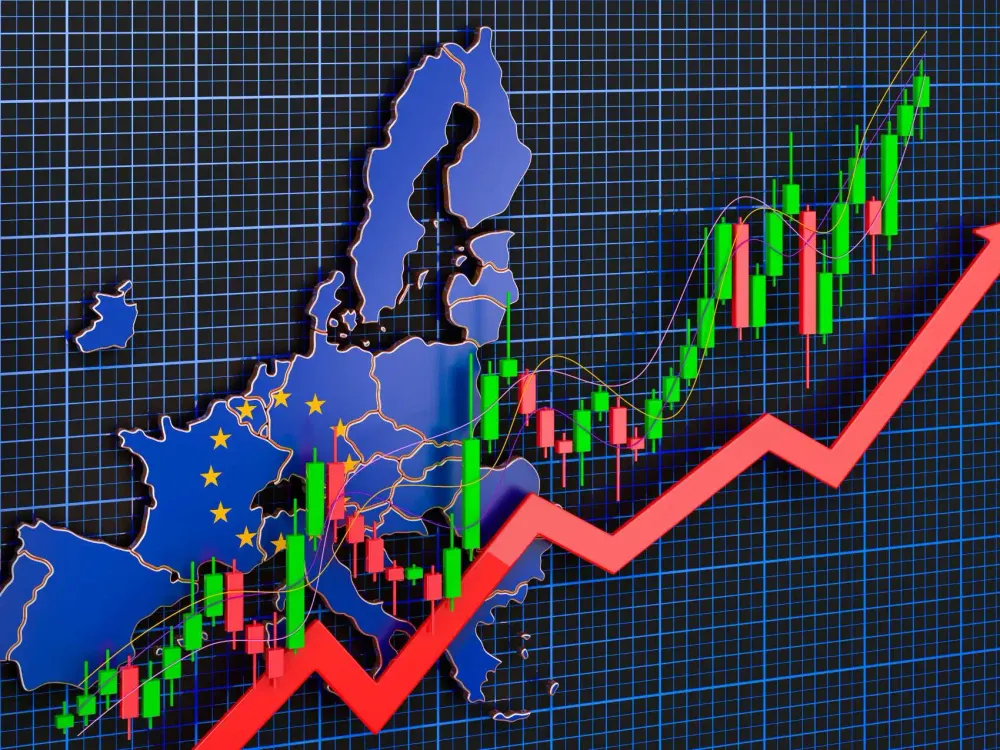
A detailed European stock market chart displaying trends and fluctuations in stock prices over a specified period.
Economic Indicators and Their Impact on Investment Strategies
Economic indicators such as inflation rates., GDP, interest rates, and employment data are essential indicators for investors to understand market trends and make informed decisions. These indicators offer useful insights into the health of the economy and guide where and when to allocate resources and invest. In this guide, we will explore and briefly overview the most important economic indicators and their impact on investment strategies. After reading this, you will have a better understanding of how to analyze and use macroeconomic indicators in your investment strategies to make better decisions.
Technical versus fundamental analysis
There are two types of market analysis employed by investors and traders, technical analysis, and fundamental analysis. Fundamental analysis employs key economic data to anticipate and understand market sentiment by looking at key macroeconomic indicators. Unlike fundamental analysis, technical analysis employs various technical indicators and tools such as a currency strength meter to gauge ongoing trends and react to them in time. The currency strength meter uses various technical data and measures the strength of currencies, where traders can detect which currencies are most powerful and highly likely to move upward when compared to weaker currencies.
Investors typically employ fundamental analysis as they aim for long-term financial goals, while financial traders prefer technical analysis tools to capitalize on short-term price movements. Financial traders also use fundamental analysis to anticipate increased volatility and lower their market exposure risks.
Gross Domestic Product (GDP): measuring economic growth
Gross Domestic Product or GDP measures the health of a country’s economy. GPD is one of the most critical economic indicators that represents the total value of goods and services produced in a country over a specific period, typically over a year. Rising GDP naturally indicates rising economic activity and growth, which leads to higher corporate profits, increased consumer spending, and a bullish stock market trend. Conversely, a declining GDP is bad for markets and the overall economy, indicating weakness and recessions. Investors use GDP trends to adjust their portfolios. When GDP is strong, stock markets usually outperform. During weak GDP growth numbers investors shift towards defensive stocks such as utilities and healthcare protecting their portfolios.
Inflation and interest rates: the balancing act
Inflation and interest rates are closely linked and have a significant influence on investment strategies and portfolio management. Inflation measures the rate at which the general level of prices for goods and services are rising, decreasing the purchasing power of a currency. Central banks, including the Federal Reserve in the United States, quickly respond to high inflation by raising interest rates, which can slow inflation and economic activities as well. This also attracts foreign investment due to higher returns on bonds and savings accounts.
For investors, rising interest rates often lead to lower bond prices and make borrowing more expensive, which slows down corporate expansion and reduces stock market returns. In other words, rising inflation is reflected positively on stock markets. Investors regularly use this information to anticipate price movements in financial markets after interest rate changes. It's not only stocks and bonds where interest rates shake prices, currency markets, and all other financial markets also “feel” the influence of interest rates and inflation. Surely, when inflation heightens, the currency weakens against other currencies, and when interest rates are increased to counteract the inflation, the currency generally strengthens.
When inflation is low and interest rates are cut, borrowing becomes cheaper as banks have lower rates for their loans. This boosts economic growth and leads to higher stock market returns. In this environment, investors typically favor equities and stocks over fixed-income securities.
Unemployment rate: key for assessing the economic stability
Unemployment rates reflect the percentage of the labor force that is unemployed and actively seeking jobs. Low unemployment rates signal a robust and growing economy, where more people are earning and spending their salaries, supporting business growth. Lower employment rates positively affect investor confidence.
However, if the employment rate is too low, it can lead to a phenomenon called wage inflation, which sometimes can prompt central banks to increase interest rates. Naturally, high unemployment rates are worse for the economy, suggesting an economic slowdown, which leads investors to consider more defensive investment strategies to lower their risks in stock markets. This is why investing is a tricky and complex task. It requires advanced techniques to manage a portfolio, often investing in several asset classes, which is never an easy task.
Consumer confidence index (CCI): gauging market sentiment
The CCI index measures the degree of optimism among consumers about the overall state of the economy and also their personal financial status. High consumer confidence translates into increased consumer spending, which not only increases profits for businesses but promotes economic growth. Higher CCI, therefore, is typically associated with rising stock prices, especially in retail consumer goods sectors. On the other hand, when CCI is declining, consumers become more cautious with their spending and the economy might experience a downturn. Investors use CCI as an indicator to adjust their portfolios and reduce exposure to consumer-driven sectors when confidence levels are declining.


